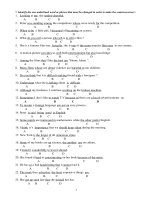optik identification mineral
Bạn đang xem bản rút gọn của tài liệu. Xem và tải ngay bản đầy đủ của tài liệu tại đây (1.67 MB, 104 trang )
OPTICAL MINERALOGY
Geology 265– Mineraloji
Meral Dogan
Lecture : optik mineraloji
Dr. Dogan’s homepage
Optik mikroskop-petrografik mikroskop-polarizan
mikroskop
Petrographic microscope
Two complimentary theories have been proposed to explain
how light behaves and the form by which it travels
Particle theory - release of a small amount of energy as a photon when
an atom is excited.
Wave theory - radiant energy travels as a wave from one point to
another.
Waves have electrical and magnetic properties => electromagnetic
variations.
Wave theory effectively describes the phenomena of polarization,
reflection, refraction and interference, which form the basis for optical
mineralogy
ELECTROMAGNETIC RADIATION
The electromagnetic radiation theory of light implies that light consists of
electric and magnetic components which vibrate at right angles to the direction
of propagation.
In optical mineralogy only the electric component, referred to as the electric
vector, is considered and is referred to as the vibration direction of the light ray.
The vibration direction of the electric vector is perpendicular to the direction in
which the light is propagating.
The behaviour of light within minerals results from the interaction of the
electric vector of the light ray with the electric character of the mineral, which is
a reflection of the atoms and the chemical bonds within that minerals.
Light waves are described in terms of velocity, frequency and wavelength.
WAVE NOMENCLATURE
REFLECTION AND REFRACTION
At the interface between the two materials, e.g. air and water,
light may be reflected at the interface or refracted
(bent) into the new medium.
For Reflection the angle of incidence = angle of reflection
.
For Refraction the light is bent when passing from one
material to another, at an angle other than perpendicular. A
measure of how effective a material is in bending light is
called the Index of Refraction (n), where:
POLARIZATION OF LIGHT
.
Light emanating from some source, sun, or a light bulb, vibrates in all
directions at right angles to the direction of propagation and is
unpolarized.
In optical mineralogy we need to produce light which vibrates in a single
direction and we need to know the vibration direction of the light ray.
These two requirements can be easily met but polarizing the
light coming from the light source, by means of a polarizing filter.
completely polarized light
Unpolarized light strikes a smooth surface, such as a pane of
glass, tabletop, and the reflected light is polarized such that its
vibration direction is parallel to the reflecting surface.
The reflected light is completely polarized only when the
angle between the reflected and the refracted ray = 90°.
Index of Refraction in Vacuum = 1 and for all other
materials n > 1.0.
Most minerals have n values in the range 1.4 to 2.0.
A high Refractive Index indicates a low velocity for
light travelling through that particular medium.
Snell's law can be used to calculate how much the light will bend on
travelling into the new medium.
If the interface between the two materials represents the boundary between
air (n ~ 1) and water (n = 1.33) and if angle of incidence = 45°,
using Snell's Law the angle of refraction = 32°.
The equation holds whether light travels from air to water, or water to air.
In general, the light is refracted towards the normal to the boundary on
entering the material with a higher refractive index and is refracted away from
the normal on entering the material with lower refractive index.
In labs, you will be examining refraction and actually determine the
refractive index of various materials.
Three types of polarization are possible.
1-Plane Polarization
2-Circular Polarization
3-Elliptical Polarization
In the petrographic microscope
In the petrographic microscope plane polarized light is used. For plane
polarized light the electric vector of the light ray is allowed to vibrate in
a single plane,producing a simple sine wave with a vibration direction
lying in the plane of polarization - this is termed plane light or plane
polarized light.
Plane polarized light may be produced by
reflection,
selective absorption,
double refraction
scattering.
Double Refraction
This method of producing plane polarized light was employed prior to selective
absorption in microscopes.
The most common method used was the Nicole Prism.
.
This method is used to produce plane polarized
light in microscopes, using polarized filters.
Some anisotropic material s have the ability to strongly absorb light vibrating
in one direction and transmitting light vibrating at right angles more easily.
The ability to selectively transmit and absorb light is termed pleochroism,
seen in minerals such as tourmaline, biotite, hornblende, (most amphiboles),
some pyroxenes.
Upon entering an anisotropic material, unpolarized light is
split into two plane polarized rays whose vibratioin directions are perpendicular
to each other, with each ray having about half the total light energy.
If anisotropic material is thick enough and strongly pleochroic, one ray is
completely absorbed, the other ray passes through the material to emerge
and retain its polarization.
PHASE AND INTERFERENCE
Before going on to examine how light inteacts with minerals we must
define one term:
RETARDATION - ∆ (delta) represents the distance that one ray lags
behind another.
Retardation is measured in nanometres, 1nm = 10-7cm, or the number
of wavelengths by which a wave lags behind another light wave.The
relationship between rays travelling along the same path and the
interference between the rays is illustrated in the following three figures.
If retardation is a whole number (i.e., 0,
1, 2, 3, etc.) of wavelengths.
The two waves, A and B, are IN
PHASE, and they constructively
interfere with each other.
The resultant wave (R) is the sum of
wave A and B.
.
When retardation is = ½, 1½, 2½ . . .
wavelengths.
The two waves are OUT OF PHASE they
destructively interfere, cancelling each other
out, producing the resultant wave (R), which
has no amplitude or wavelength
If the retardation is an intermediate value, the the
two waves will:
be partially in phase, with the interference being
partially constructive and be partially out of phase,
partially destructive
If a mineral is placed at 45° to the vibration directions of the polarizers the
mineral yields its brightest illumination and percent transmission (T).
MONOCHROMATIC LIGHT
Dark areas where retardation is a whole number of wavelengths.
light areas where the two rays are out of phase,
Retardation development









